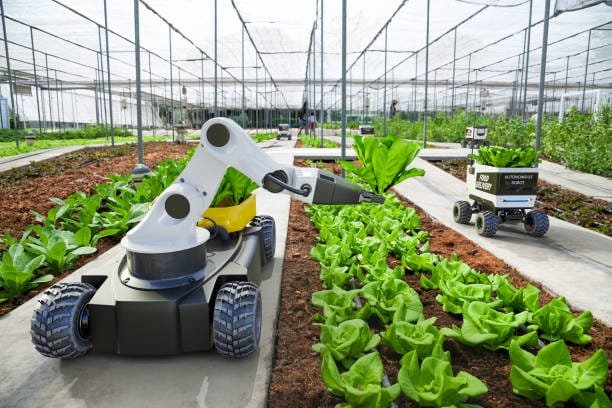How Artificial Intelligence (AI) is Revolutionizing Agriculture
Artificial Intelligence (AI) is transforming the agriculture sector by making farming smarter, more efficient, and sustainable. With advancements in AI, farmers now have access to innovative tools that help them optimize their resources, improve crop yields, and address global food challenges. From predictive analytics to robotics, AI is paving the way for the future of agriculture.
How AI Can Be Used in Agriculture and Farming
AI is used in agriculture to solve critical challenges such as resource optimization, pest management, and weather predictions. Here are some ways AI can be applied in farming:
- Precision Farming:
AI helps monitor soil conditions, weather, and crop health through IoT sensors and drones. This ensures that resources like water, fertilizers, and pesticides are used efficiently, reducing waste and cost. - Crop Health Monitoring:
AI-powered drones and satellite imagery can detect diseases or nutrient deficiencies in crops early. This allows farmers to take corrective actions before significant damage occurs. - Yield Prediction:
Machine learning models analyze historical and current data to predict crop yields accurately. This helps farmers plan better and reduces financial risks. - Pest and Weed Management:
AI systems use computer vision to identify pests and weeds, enabling precise spraying of pesticides. This minimizes environmental impact and increases crop quality. - Robotics in Farming:
Autonomous robots are used for planting, weeding, and harvesting. These robots reduce labor dependency and increase productivity.
What is the Application of Artificial Intelligence in Agriculture?
Artificial Intelligence has diverse applications in agriculture, including:
- Smart Irrigation:
AI sensors measure soil moisture levels and automatically control irrigation systems, ensuring crops get the right amount of water. - Livestock Monitoring:
Wearable AI devices track animal health, behavior, and location. For instance, AI can detect early signs of disease in cattle, allowing farmers to intervene promptly. - Supply Chain Optimization:
AI helps in predicting market demand, ensuring that farmers produce the right quantity of crops and reduce wastage during transportation. - Climate Smart Farming:
AI tools provide insights on adapting farming practices to changing climate conditions, helping farmers mitigate risks.
How is AI Technology Used in Agriculture?
AI technology integrates machine learning, robotics, and data analytics into farming processes:
- Predictive Analytics:
AI analyzes weather data to provide farmers with forecasts. This helps them decide the best time to sow, irrigate, or harvest. - Automated Machinery:
Tractors and harvesters equipped with AI can perform tasks autonomously, reducing manual labor and time. - Drone Technology:
Drones capture high-resolution images of fields, enabling farmers to assess crop health and irrigation needs in real-time. - Blockchain for Agriculture:
AI combines with blockchain to ensure traceability in the supply chain, providing consumers with transparency about the source of their food.
Why Are Machines Used for Farming in the USA?
The use of machines in farming is widespread in the USA due to:
- Labor Shortages:
With fewer people working in agriculture, machines like AI-powered tractors and harvesters help fill the gap. - Efficiency and Scale:
Farms in the USA are typically large-scale operations. Machines ensure that tasks like planting and harvesting are completed efficiently. - Cost-Effectiveness:
While machines have a high initial cost, they reduce long-term labor expenses, making farming more profitable. - Technological Advancements:
The USA is a leader in agricultural technology, and farmers adopt innovations like AI-driven systems to stay competitive.
How Can We Use AI in Agriculture?
Using AI in agriculture involves several practical steps:
- Data Collection:
Farmers can install sensors in fields to collect data on soil quality, weather, and crop health. - AI Tools:
Platforms like Blue River Technology or CropIn use AI to analyze collected data and provide actionable insights. - Training Models:
Farmers can use machine learning algorithms to train AI models on local conditions, ensuring accurate predictions. - Integration with Equipment:
AI can be integrated with existing machinery for tasks like automated irrigation, pest control, and harvesting.
Benefits of AI in Agriculture
- Higher Yields:
AI helps optimize resources, ensuring maximum productivity from every hectare of land. - Cost Reduction:
By minimizing resource wastage and automating tasks, AI reduces overall farming costs. - Sustainability:
AI promotes sustainable practices by reducing chemical use and conserving water. - Better Market Insights:
AI tools predict market trends, helping farmers grow crops that are in high demand.
Challenges of AI in Agriculture
Despite its benefits, AI faces some challenges in agriculture:
- High Costs: Advanced AI systems are expensive, making them inaccessible for small-scale farmers.
- Lack of Technical Knowledge: Many farmers need training to use AI tools effectively.
- Data Privacy: Concerns about who owns the data collected by AI systems remain unresolved.
Conclusion
AI is reshaping agriculture by making it more efficient, sustainable, and productive. From precision farming to autonomous machinery, the potential of AI in agriculture is immense. However, to fully realize its benefits, governments and organizations need to address challenges like cost and accessibility.
By embracing AI, farmers can meet the growing demand for food while conserving resources and protecting the environment. The future of farming is not just in the soil but also in the technology that helps us nurture it.


